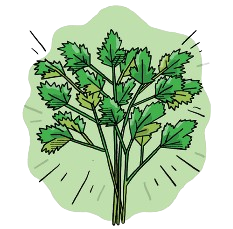Get seasonal selections of heirloom seeds sent to your place, join Grow It Local +
How to grow
Join Our Community
Learn to grow and cook healthy, delicious, organic food at home by joining our seasonal grow-alongs.
Join Our Community
Learn to grow and cook healthy, delicious, organic food at home by joining our seasonal grow-alongs.
Growing Tips and Tricks
Location:
Parsley prefers a location with partial shade to full sun. It can tolerate some shade, especially in hot climates. Choose well-draining soil that is rich in organic matter.
Watering:
Parsley requires consistent moisture to grow well. Keep the soil evenly moist but not waterlogged. In hot weather, you may need to water more frequently, but in cooler weather, watering once or twice a week should be sufficient.
Problems:
Pests: Parsley is relatively pest-resistant, but keep an eye out for aphids and caterpillars. Use neem oil to manage pest infestations.
Diseases: Parsley is generally disease-resistant but can be susceptible to fungal issues in humid conditions. Ensure good air circulation around the plants and avoid overhead watering.
Bolting: Parsley is a biennial, which means it can bolt and flower in its second year. To extend its life, harvest the leaves regularly to promote continuous growth.
Harvest:
Parsley leaves can be harvested once the plant has grown to a sufficient size. Harvest the outer leaves first, leaving the centre leaves to continue growing. Snip the leaves close to the base of the plant. If you need larger quantities of parsley, you can cut entire stems.
Background
Parsley is believed to have originated in the Mediterranean region, particularly in Southern Europe and the Middle East. It has been cultivated for over 2,000 years and was highly valued by ancient civilizations like the Greeks, Romans, and Egyptians.
The ancient Greeks associated parsley with festivities and used it to make wreaths for celebrating victorious athletes. They also believed that chewing parsley could help mask strong odours, making it a common practice to consume parsley after meals.
The name parsley translates in greek to rock celery, in reference to its habit of thriving amongst rocks and walls
In ancient Rome, parsley was used both as a culinary herb and as a decorative garnish for elaborate dishes. It was also believed to have medicinal properties and was used in traditional herbal medicine.
So fond of parsley was the holy roman emperor, Charles the great, that he had it growing all over his imperial estate.
Parsley made its way to other parts of the world through trade and exploration. During the Middle Ages, it became popular in European monastic gardens and gradually spread to various regions.
Health Benefits
Homegrown, organic parsley is good for you!
It’s a good source of vitamins (A, C, K) and minerals (iron and calcium)
Eating parsley can immune function, bone health, and healthy skin due to its vitamin content.
It’s rich in antioxidants, such as flavonoids and volatile oils, which help combat inflammation and oxidative stress. Parsley is also rich in chlorophyll, which may aid in detoxification processes in your body.
Patch to plate
Parsley is an essential inclusion in any kitchen garden. Any savoury dish can be elevated by popping out into the garden, grabbing a few leaves of parsley, chopping them up or tearing them, then sprinkling them over the top of your culinary creations. That’s not all you can do with parsley though, here’s a few extra suggestion to use this flavour packed herb:
- Served up with bulgur, tomato, cucumber and mint as a part of a delicious Tabbouleh
- Served up with linguini pasta, garlic, anchovies and white wine
- Combined with chicken,leek and flaky puff pastry in a delicious, creamy pot pie




